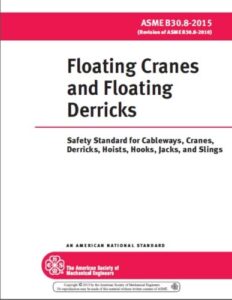ASME B30.8-2015 Floating Cranes and Floating Derricks
ASME B30.8-2015 Floating Cranes and Floating Derricks
ASME B30.8-2015 Floating Cranes and Floating Derricks Standard contains provisions that apply to the construction, installation, operation, inspection, testing, maintenance, and use of cranes and other lifting and material-movement related equipment. For the convenience of the reader, the Standard has been divided into separate volumes. Each volume written under the direction of the ASME B30 Standard Committee and has successfully completed a consensus approval process under the general auspices of the American National Standards Institute (ANSI).
The B30 Standard is intended to
(a) prevent or minimize injury to workers, and other-wise provide for the protection of life, limb, and property by prescribing safety requirements.
(b) provide direction to manufacturers, owners,employers, users, and others concerned with, or respon-sible for, its application.
(c) guide governments and other regulatory bodies in the development, promulgation, and enforcement of appropriate safety directives.
You can also Read ASME A17.3-2015 Safety Code for Existing Elevators and Escalators
ASME B30.8-2015 Floating Cranes and Floating Derricks content
- Foreword
![ASME B30.8-2015]()
- Committee Roster
- Introduction
- Summary of Changes
- Scope, Definitions, Personnel Competence, Translations, and References
- Construction and Installation
- Inspection, Testing, and Maintenance
- Operation
- Figures
- Table
The equipment covered by the B30 Standard is subject to hazards that cannot abated by mechanical means, but only by the exercise of intelligence, care, and common sense. It is therefore essential to have personnel involved in the use and operation of equipment who are competent, careful, physically and mentally qualified, and trained in the proper operation of the equipment and the handling of loads. Serious hazards include, but not limited to, improper or inadequate maintenance, overloading, dropping or slipping of the load, obstructing the free passage of the load, and using equipment for a purpose for which it not intended or designed.


Comments are closed.